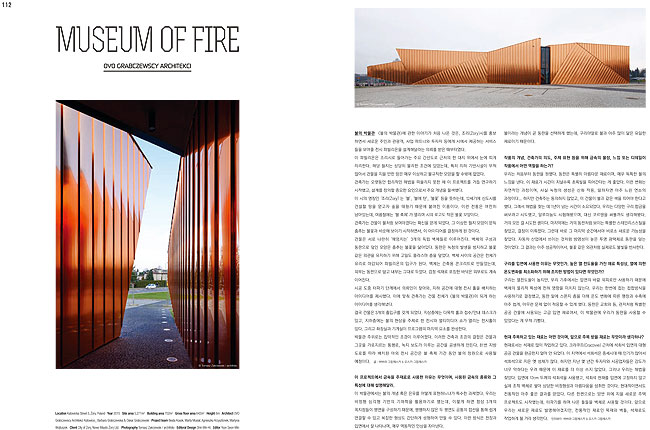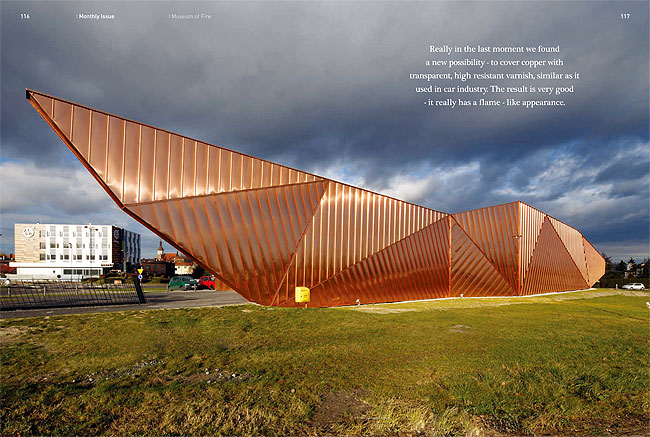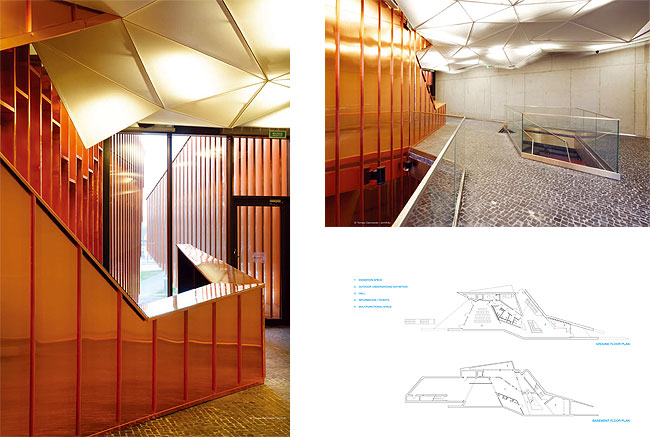Museum of Fire
Architect :OVO Grabczewscy Architekci



불의 박물관 <불의 박물관>에 관한 이야기가 처음 나온 것은, 조리(Zory)시를 홍보 하면서 새로운 주민과 관광객, 사업 파트너와 투자자 등에게 시에서 제공하는 서비스 들을 보여줄 전시 파빌리온을 설계해달라는 의뢰를 받은 때부터였다. 이 파빌리온은 조리시로 들어가는 주요 간선도로 근처의 한 대지 위에서 눈에 띠게 자리한다. 해당 필지는 상당히 불리한 조건에 있었는데, 특히 지하 기반시설이 무척 많아서 건물을 지을 만한 땅은 매우 이상하고 불규칙한 모양을 할 수밖에 없었다. 건축가는 오랫동안 합리적인 해법을 떠올리지 못한 채 이 프로젝트를 거듭 연구하기 시작했고, 설계를 정의할 중요한 요인으로서 주요 개념을 물색했다. 이 시의 명칭인‘ 조리(Zory)’는‘ 불’,‘ 불에 탄’,‘ 불꽃’ 등을 뜻하는데, 12세기에 신도시를 건설할 땅을 얻고자 숲을 태웠기 때문에 붙여진 이름이다. 이런 전통은 여전히 남아있는데, 여름철에는‘ 불 축제’가 열리며 시의 로고도 작은 불꽃 모양이다. 건축가는 건물이 불처럼 보여야겠다는 확신을 얻게 되었다. 그 이상한 필지 모양이 문득 춤추는 불꽃과 비슷해 보이기 시작하면서, 이 아이디어를 결정하게 된 것이다. 건물은 서로 나란히 ‘헤엄치는’ 3개의 독립 벽체들로 이루어진다. 벽체의 구성과 동판으로 덮인 모양은 춤추는 불꽃을 닮아있다. 동판은 녹청의 발생을 방지하고 불꽃 같은 외관을 유지하기 위해 고밀도 플라스마 층을 덮었다. 벽체 사이의 공간은 전체가 유리로 마감되어 파빌리온의 입구가 된다. 벽체는 건축용 콘크리트로 만들었는데, 외부는 동판으로 덮고 내부는 그대로 두었다. 검정 석재로 포장한 바닥은 외부로도 계속 이어진다. 시공 도중 터파기 단계에서 의뢰인이 찾아와, 지하 공간에 대형 전시 홀을 배치하는 아이디어를 제시했다. 이에 맞춰 건축가는 건물 전체가 <불의 박물관>이 되게 하는 아이디어를 생각해냈다. 결국 건물은 3개의 출입구를 갖게 되었다. 지상층에는 다목적 홀과 접수/안내 데스크가 있고, 지하층에는 불의 현상을 주제로 한 전시와 멀티미디어 쇼가 열리는 전시홀이 있다. 그리고 화장실과 기계실이 프로그램의 마지막 요소를 완성한다. 박물관 주위로는 집약적인 조경이 이루어졌다. 이러한 건축과 조경의 결합은 건물과 그곳을 가로지르는 통행로, 녹지 보도가 이루는 공간을 공생하게 만든다. 81번 지방 도로를 따라 배치된 야외 전시 공간은 불 축제 기간 동안 불의 정원으로 사용될 예정이다.
글 : 바바라 그랍체스카 & 오스카 그랍체스카
이 프로젝트에서 금속을 주재료로 사용한 이유는 무엇이며, 사용된 금속의 종류와 그 특성에 대해 설명해달라.
이 박물관에서는 불의 개념 혹은 은유를 어떻게 표현하느냐가 특수한 과제였다. 우리는 비정형 삼각형 기반의 기하학을 활용하기로 했는데, 이렇게 하면 항상 3개의 꼭지점들이 평면을 구성하기 때문에, 평행하지 않은 두 평면도 공통의 접선을 통해 쉽게 연결할 수 있고 복잡한 형상도 간단하게 성형하여 만들 수 있다. 이런 방식은 천장과 입면에서 잘 나타나며, 매우 역동적인 인상을 자아낸다. 불이라는 개념이 곧 동판을 선택하게 했는데, 구리야말로 불과 아주 많이 닮은 유일한 재료이기 때문이다.
작품의 개념, 건축가의 의도, 주제 표현 등을 위해 금속의 물성, 느낌 또는 디테일이 작품에서 어떤 역할을 하는가?
우리는 처음부터 동판을 원했다. 동판은 특별히 아름다운 재료이며, 매우 독특한 불의 느낌을 낸다. 이 재료가 시간이 지날수록 초록빛을 띠어간다는 게 좋았다. 이런 변화는 자연적인 과정이며, 사실 녹청의 생성은 산화 작용, 말하자면 아주 느린 연소의 과정이다... 하지만 건축주는 동의하지 않았고, 이 건물이 불과 같은 색을 띠어야 한다고 했다. 그래서 해법을 찾는 데 1년이 넘는 시간이 소요되었다. 우리는 다양한 구리 합금을 써보려고 시도했고, 알루미늄도 시험해봤으며, 대신 코르텐을 써볼까도 생각해봤다. 거의 모든 걸 시도한 셈이다. 마지막에는 거의 동판처럼 보이는 특별한 스테인리스스틸을 찾았고, 결정이 이뤄졌다. 그런데 바로 그 마지막 순간에서야 비로소 새로운 가능성을 찾았다. 자동차 산업에서 쓰이는 것처럼 방염성이 높은 투명 광택제로 동판을 덮는 것이었다. 그 결과는 아주 성공적이어서, 불꽃 같은 외관처럼 실제로도 불빛을 반사한다.
구리를 입면에 사용한 이유는 무엇인가. 높은 열 전도율을 가진 재료 특성상, 열에 의한 온도변화를 최소화하기 위해 조치한 방법이 있다면 무엇인가?
구리는 열전도율이 높지만, 우리 기후에서는 입면의 바깥 외피로만 사용하기 때문에 벽체의 물리적 특성에 전혀 영향을 미치지 않는다. 우리는 한번에 접는 접합방식을 사용하기로 결정했고, 동판 밑에 스폰지 층을 더해 온도 변화에 따른 팽창과 수축에 아주 쉽게, 아무런 문제 없이 적응할 수 있게 했다. 동판은 교회와 돔, 관저처럼 특별한 공공 건물에 사용되는 고급 입면 재료여서, 이 박물관에 우리가 동판을 사용할 수 있었다는 게 무척 기뻤다.
현재 주목하고 있는 재료는 어떤 것이며, 앞으로 주목 받을 재료는 무엇이라 생각하나?
현재로서는 석재로 많이 작업하고 있다. 크라쿠프(Cracovie) 근처에 석회석 입면의 대형 공공 건물을 완공한지 얼마 안 되었다. 이 지역에서 석회석은 중세시대 때 인기가 많아서 석회석으로 지은 옛 성채가 많다. 하지만 지난 몇 년간 투자자와 시공업자들은 강도가 너무 약하다는 우려 때문에 이 재료를 더 이상 쓰지 않았다. 그러나 우리는 해법을 찾았다. 입면에 12cm 두께의 석회석을 사용했고, 석회석 판재를 입면에 고정하지 않고 실제 조적 벽체로 쌓아 상당한 비정형성과 아름다움을 성취한 것이다. 현대적이면서도 전통적인 아주 좋은 결과를 얻었다. 다른 한편으로는 암반 위에 지을 새로운 주택 프로젝트도 시작했는데, 터파기를 하며 나온 돌들을 벽체로 사용할 것이다. 앞으로 우리는 새로운 재료도 발명해야겠지만, 전통적인 재료인 목재와 벽돌, 석재로도 작업하게 될 거라 생각한다.
인터뷰이: 바바라 그랍체스카 & 오스카 그랍체스카
The story of
Written by Barbara Grabczewska & Oskar Grabczewski
Is there any particular reason for using Metal as main material for this project? And what types of Metal have you used in this project, and what general properties do they have?
In our museum we had specific task - how to express the notion or metaphor of fire. We decided to use geometry based on irregular triangles. 3 points always constitute the plane, and you can easily connect two non-parallel planes to each other by common edge, creating in this simple way moulded, complex topography. It is well visible in the ceiling and in the facade and it gives very dynamic impression. The idea of fire immediately brought us to copper - it is the only material that resembles fire so much.
How did the materiality, feeling and details of Metal affect the project in terms of concept, the intention of architect and its presentation?
We wanted the copper from the very beginning. It is an exceptionally beautiful material, and it has very unique fiery look. We liked the idea that it will become green with time - it is a natural process, and in fact patination is oxidation, that is - a very slow burning... But the client was unconvinced ad he insisted that the building should stay fiery in color. It took us more than one year to find solution - we tried to use different copper alloys, we tested aluminium, we thought about turning to corten, we tried almost everything. Finally we found special stainless steel that looked almost like copper. The decision was made. And then, really in the last moment we found a new possibility - to cover copper with transparent , high resistant varnish, similar as it used in car industry. The result is very good - it really has a flame - like appearance.
For what reasons did you finish the facade with Copper? Considering its material characteristics like high thermal conductivity, what is the method, if any, you applied to minimize the change of temperature by heat?
The copper has high thermal conductivity, but in our climate we use it only as a outer layer of facade, so it does not affect the physics of the wall at all. We decided to use single fold connection and we added a sponge layer beneath the copper, so it can adapt very easily to changing temperature by expanding and dimishing without any problems. The copper is high class facade material, used for exclusive public buildings like churches, domes, palaces, so we were very glad, that we could use it for our museum.
What material are you looking at now? And do you think what material will get much attention in the future?
Right now we are working a lot with stone. We just finished a large public building near Cracovie that has a limestone facade. A limestone was very popular in medievial times in this area - there are many old castles built with it, but in last years investors and contractors did not use this material any more, because they were afraid that it is too soft. We found a solution and used 12cm thick layer of limestone for facade - they are not plates fixed to facade, but real masonry wall, very irregular and very beautiful. The result is very good - modern and traditional at the same time. We also started a new project - a house that will be built on the rock, and the stone excavated from the foundations will be used for the walls. I think we should invent new materials but also work with traditional ones ? wood, brick, stone.
Interviewee: Barbara Grabczewska & Oskar Grabczewski
건축문화 2016년 5월호 [Monthly Issue]페이지 © 에이엔씨출판(주)